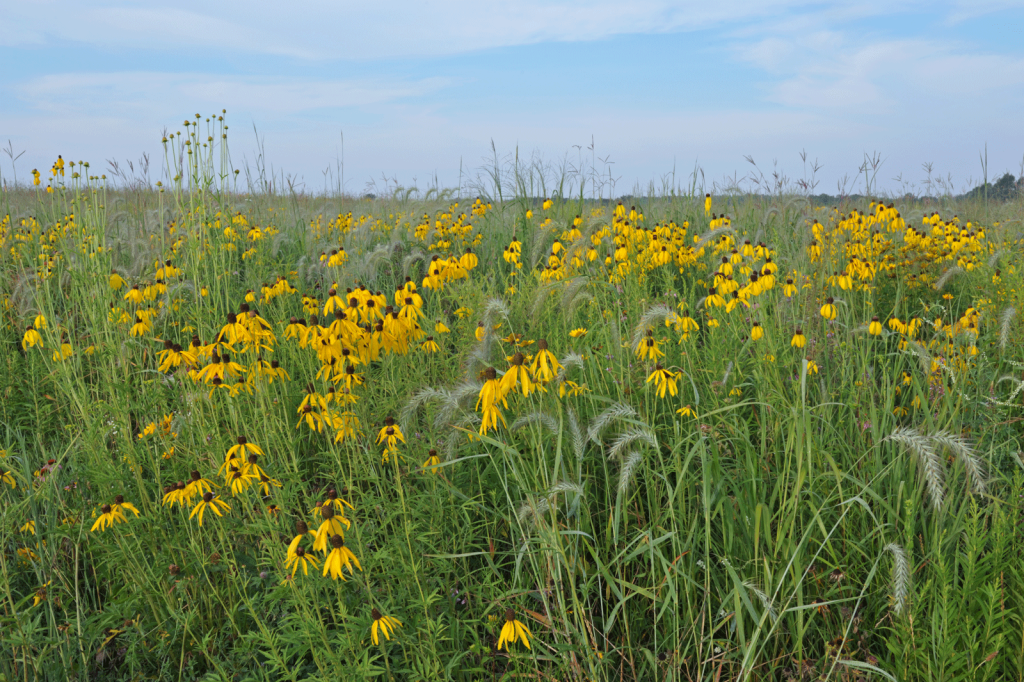
A detailed comparison of the Conservation Reserve Program (CRP) and the Conservation Reserve Enhancement Program (CREP) to help landowners determine the best fit for their conservation goals.
For landowners looking to improve natural resources, protect soil and water, and enhance wildlife habitat, both the Conservation Reserve Program (CRP) and the Conservation Reserve Enhancement Program (CREP) offer valuable opportunities. But while the two programs share similar conservation goals, they differ in their structure, funding, and focus areas.
At All Native Seed, we work closely with landowners enrolled in both CRP and CREP, supplying high-quality, NRCS-compliant native seed mixes tailored to each program’s unique requirements. If you’re weighing your options, here’s what you need to know about the differences and benefits of CRP and CREP.
What Is CRP?
The Conservation Reserve Program (CRP) is a federal initiative administered by the USDA Farm Service Agency (FSA). It provides financial incentives to landowners who agree to remove environmentally sensitive land from agricultural production and plant native grasses, forbs, trees, or other conservation covers.
Key Goals of CRP:
- Reduce soil erosion
- Improve water quality
- Enhance wildlife habitat
- Increase carbon sequestration
- Restore wetlands and grasslands
CRP contracts typically last 10 to 15 years and provide annual rental payments and cost-share assistance for approved conservation practices like CP1, CP2, CP4D, CP23, and CP42.
What Is CREP?
The Conservation Reserve Enhancement Program (CREP) is a partnership between the USDA and individual states, tribes, or local governments. CREP builds on the CRP framework but focuses on specific, high-priority conservation issues in defined geographic areas, such as improving water quality in watersheds or restoring wildlife habitat for declining species.
CREP Enhancements Include:
- Higher payment rates and incentives than general CRP
- More targeted goals, like nitrate reduction, flood mitigation, or species protection
- Flexibility to address local conservation priorities
- Shorter or longer contract options, depending on the program
Because CREP is designed to meet region-specific goals, it’s often used to protect waterways, riparian areas, wetlands, or buffer zones on working lands.
CRP vs. CREP: A Side-by-Side Comparison
| Feature | CRP | CREP |
| Administered by | USDA-FSA (Federal) | USDA-FSA + State/Tribal/Local Partners |
| Primary Focus | General conservation: erosion, water, wildlife | Targeted conservation in high-priority areas |
| Geographic Scope | Nationwide | Limited to designated watersheds or regions |
| Financial Incentives | Annual rental payments, cost-share | Higher rental payments, bonuses, additional cost-share |
| Contract Length | 10–15 years | Flexible; varies by state and program goals |
| Land Eligibility | Environmentally sensitive agricultural land | Focused on riparian buffers, wetlands, or species habitats |
| Examples of Practices | CP2 (Native Grasses), CP42 (Pollinators), CP23 (Wetlands) | Similar practices, with specific enhancements |
Which Program Is Right for You?
Choosing between CRP and CREP depends on several factors, including your location, land type, conservation goals, and financial priorities. Here are a few considerations:
Choose CRP if:
- You want to address general soil, water, and habitat concerns
- You’re enrolling large fields or marginal cropland
- You’re looking for a straightforward, long-term conservation plan
- You’re not located in a CREP-eligible area
Choose CREP if:
- Your land is in a CREP-approved region or watershed
- You want to protect streambanks, buffer zones, or wetlands
- You’re interested in enhanced incentives or more flexible contract options
- You’re committed to helping solve a specific local environmental issue
How All Native Seed Supports CRP and CREP Projects
Whether you’re enrolled in CRP or CREP, your success depends on choosing the right native seed and establishing a diverse, resilient habitat.
At All Native Seed, we provide:
- NRCS-compliant native seed mixes tailored to your program and location
- Pollinator-friendly and erosion-control species for specific conservation goals
- Wetland and riparian seed mixes for buffer strips and floodplain areas
- Guidance on seeding methods, timelines, and documentation for compliance
With over 400,000 acres of successful plantings, we understand how to match the right seed to your contract requirements, no matter which program you’re enrolled in.
Both Programs Deliver Lasting Impact
CRP and CREP are both powerful tools for improving land stewardship, restoring native ecosystems, and protecting natural resources. Whether your focus is broad conservation or targeted habitat enhancement, either program (when paired with the right planning and support) can provide meaningful environmental and economic benefits.
Need help getting started or sourcing compliant seed?
Contact All Native Seed today for expert recommendations and high-quality native seed tailored to your CRP or CREP project.
